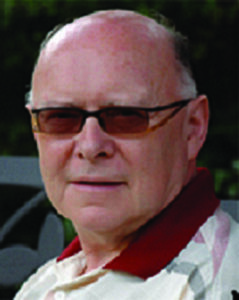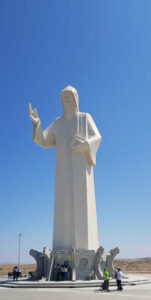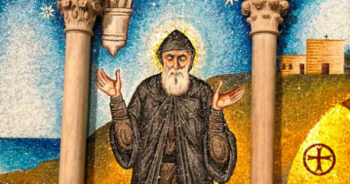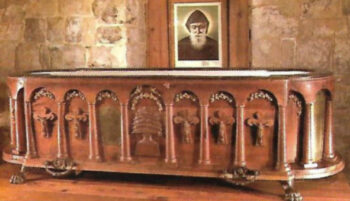St Charbel

By Anthony E Dundon
The Miraculous Intercessions of a Humble and Holy Hermit
Situated 1,800 metres above sea level, Bekaa Kafra is the highest village in Lebanon, with some spectacular views of the Qadisha Valley and the Monastery of St Anthony the Great of Lebanon. Home of the Maronite Church, founded by the eponymous St Maron, who relocated from Antioch to north Lebanon, Bekaa Kafra is also the birthplace of Youssef Makhlouf – St Charbel (1828–1898).

Monument outside St Charbel Church,
Faraya, Lebanon
Youssef Makhlouf was born on 8 May 1828, the fifth child of poor, pious parents. Brigitta, his mother, was a regular communicant and prayed fervently with her children. When Youssef was three, his father died in the course of military service. The family were dependent on their uncle who provided support until Brigitta remarried. She was close to a very religious man, Lahoud, who wanted to become a priest, and supported his decisions, knowing that the Eastern Church allowed priests to marry. And when Lahoud had completed his studies, they became man and wife.
Youssef cared for the younger members of his family, often ensuring that they prayed at a local grotto where he kept a statue of the Madonna. His stepfather, Father Dominik, taught him how to read and write and to pray and sing the Mass. A young girl, Mariam, was attracted to this tall, handsome man, but she knew that there was little chance of a romantic relationship.
When he was 24, he left home to join the Maronites at the monastery of Our Lady of Maifouq. Here he spent a year as a novice. His uncle needed him on the farm and his mother was not convinced that he had a vocation. They visited him during his novitiate, as they wanted him to return home. His mother told him: “If you think you may be a bad priest, it might be better to come home. But if this is God’s will, then he will help you to become a good priest.”
Youssef fasted regularly and was intent on consecrating his life to God. He made his first profession in 1853, at which time he received the religious habit. He chose the name ‘Charbel’ after a second-century Antioch Christian martyr. Always obedient and respectful to the other monks, he completed his novitiate at the Orthodox Catholic Monastery of St Maron, Beqaa Valley, where he took his vows, living an even stricter life that was devoted to self-discipline, obedience and hard work.

Image of St Charbel in St Patrick’s Cathedral, New York
He studied theology at Kfifan, Batroun Monastery, north Lebanon, and was ordained on 23 July 1859. He was pleased to be sent to the monastery of St Maron, Annaya. While there, he received a big surprise when relatives and parishioners, including Mariam, now married, arrived to receive his blessing. They asked him to come to their village to celebrate a Mass, but he was not allowed to leave the monastery. Charbel, who would wear the same threadbare habit in summer and winter, despite the cold, now commenced an even more ascetic life, distancing himself from the world and withdrawing into solitude to get closer to God through prayer and meditation. It was here that he studied holy books with another monk called Hardinie, later St Hardinie.
Tall and thin and always sombre, he prayed fervently and did not eat meat or fruit. He tiptoed through the corridors of the monastery, wrapped in his thoughts that were solely for God. A great believer in Our Lady’s protection, he said: “If you want to be saved, then pray to Our Lady with all your heart and she will bring you salvation.”
In 1875, the abbot gave him permission to live for the rest of his life in a nearby hermitage. He seldom spoke to the other monks at the monastery. If they met, he would ask them to read aloud a passage from a holy book. He maintained that this was their opportunity to learn something special about a saint.
At confession, he had the amazing gift of seeing into the heart of sinners and leading penitents closer to God. Sometimes he delivered hard penances, but people sought his help and advice, as did a man whom he healed of typhus -- spread by lice and fleas -- with prayer and holy water.
In 1885, a plague of locusts devastated the fields and crops near the monastery. The destruction they caused eventually led to famine, and the farmers quickly sought help from the Father Superior at the monastery. Charbel was asked to go to the fields where he prayed and sprinkled holy water on the land. When he imparted his final blessing, the locusts disappeared. The farmers were amazed at what they witnessed and continued to give him praise for this miracle. Calmly responding to them, Charbel said: “God bless you and your fields,” and he returned to the monastery. One day, people from Annaya brought a man possessed by a devil to the monastery. The man was uncontrollable. Charbel ordered him inside, and then placed a Bible on his head. The evil spirits left the man and to everyone’s amazement he became tranquil and composed.
Charbel used to kneel for hours before the tabernacle. In mid-December 1898, he stumbled while saying Mass. When he tried to raise the Eucharist with his frozen hands, another friar helped him to hold the chalice. Afterwards, the other monks took him to his cell, where he remained until Christmas Eve when, after he received the Sacrament of Anointing, he surrendered his soul to his Creator. He was laid before the altar with four candles around his body.
His funeral was conducted according to Maronite tradition – his body was buried directly in the earth at Maron Monastery. When, five months after his death, it was reported that a bright light had been shining from his grave to the tabernacle of the monastery chapel, the Superior at the monastery ordered Charbel’s exhumation. They found that his body was intact and covered in a blood-like fluid resembling resin. They wrapped Charbel’s remains in a white sheet and placed it in a coffin in the chapel. However, they found that the sheet was soon stained with the same fluid. Many pilgrims came seeking his help and such was the interest that the friars had to place him in a stone grave.
An exhumation took place in 1927, as the walls of his grave started to leak the same blood-like fluid. When the grave was opened, his body was still intact and coated in the strange substance. After many cases of healing were reported, Charbel was reinterred at a different location.
Following reports documenting the healing of at least two people, his cause for canonisation was commenced in 1925 by Pope Pius XI. In 1954, Pope Pius XII signed a decree for his proposed beatification. The Vatican had to prove the worthiness of Charbel’s life as well as miracles. The first healing was in 1937. Mr Iskandra Obeid, a blacksmith, developed blindness when a piece of metal damaged his eye. He was a fervent follower of Charbel and one night the monk appeared to him in a dream and instructed him to go to his tomb and pray, which he did. When he reached the tomb, he felt a stinging pain in his eye, and later, when he opened it, his sight was restored.

St Charbel’s new tomb
The second healing was in a thirty-year-old nun, Sister Able Kamary, an invalid for fourteen years. She suffered from stomach ulceration and her pancreas, gallbladder and kidneys were matted together. Despite surgery, she was in constant pain and attacks of severe vomiting meant she was unable to eat. By 1942, she was emaciated and paralysed in one arm and needed a walking stick. In 1950, she requested to be taken to Charbel’s tomb. When she touched the leaking liquid, she was cured.
On 5 December 1965 Pope Paul VI beatified Charbel and on 9 October 1977, he was canonised. St Charbel’s message to humanity was one of great spirituality: communication with God is not only possible, but is the privilege of all Christians. His feast day is on 24 July.
 Entries(RSS)
Entries(RSS)